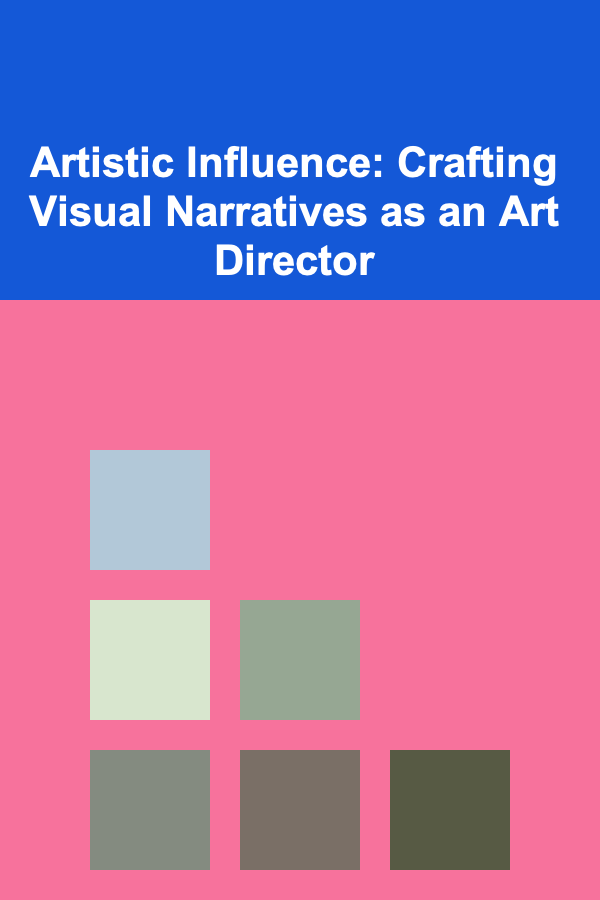
Artistic Influence: Crafting Visual Narratives as an Art Director
ebook include PDF & Audio bundle (Micro Guide)
$12.99$7.99
Limited Time Offer! Order within the next:

As an Art Director, the primary responsibility is to create and oversee the visual direction of a project, whether it's a brand campaign, digital media, or a product design. The role demands a deep understanding of art, design principles, and storytelling. An Art Director must craft visual narratives that resonate with the audience while conveying the underlying message of the project. These narratives are not simply about aesthetics---they're about emotion, context, and purpose.
Creating compelling visual narratives requires more than technical skill. It demands creativity, innovation, and a keen understanding of how visual elements can influence perception and emotion. This actionable guide dives into the key elements that contribute to successful visual storytelling and offers insights on how Art Directors can leverage their artistic influence to craft meaningful narratives.
Understanding the Power of Visual Storytelling
Visual storytelling is more than just combining pretty pictures; it's about conveying a message, evoking emotions, and creating a memorable experience. As an Art Director, understanding the impact of visuals on storytelling is crucial for ensuring your work not only looks good but communicates effectively.
The Psychology of Visuals
Visuals are processed by the brain faster than text, and they have a unique ability to evoke emotions and trigger memories. Colors, shapes, textures, and compositions all carry psychological significance. For example, warm colors like red and orange can evoke energy and passion, while cool colors like blue and green can create calmness and trust. A well-designed visual narrative taps into these subconscious associations, guiding the audience's emotional response.
Crafting the Story Through Design Elements
Every element in a visual design---from typography and layout to color scheme and imagery---contributes to the overall narrative. The key is to use these elements intentionally to support the story you want to tell. For example, in a campaign aiming to evoke nostalgia, you might use vintage typography and warm, muted colors. A minimalist design could create a modern, sleek narrative, while a complex, layered composition might suggest depth and complexity.
Developing a Strong Concept
At the heart of any visual narrative lies a compelling concept. As an Art Director, you must be able to translate abstract ideas into tangible visuals that communicate the essence of the project. This requires a blend of creativity, intuition, and a deep understanding of the project's objectives.
The Importance of Research and Inspiration
Every great concept starts with research. Whether you're working on a branding project, a film, or an advertising campaign, understanding the core message, the target audience, and the cultural context is vital. Inspiration can come from anywhere---art history, nature, architecture, or even current events. By exploring various sources of inspiration, you can create a rich visual language that speaks to the audience.
Developing Mood Boards
Mood boards are a crucial tool for developing visual concepts. They allow you to collect and organize visual references that reflect the tone, mood, and style you aim to achieve. These can include images, colors, textures, typography, and even phrases or words that encapsulate the project's essence. A well-curated mood board acts as a visual compass, helping ensure consistency throughout the creative process.
Concept Refinement
Once you've developed an initial concept, the next step is to refine and clarify the idea. This may involve sketching, creating mockups, or experimenting with different compositions. Refinement also means aligning the concept with the project's goals and constraints, whether they be budgetary, technical, or time-based. A good Art Director can pivot and adapt the concept as necessary while staying true to the overall vision.
Communicating the Narrative Through Composition
Composition refers to the arrangement of visual elements within a design. How these elements are placed within the frame plays a pivotal role in guiding the viewer's eye, creating focal points, and establishing the visual hierarchy.
The Rule of Thirds
One of the most fundamental principles in composition is the rule of thirds. This technique involves dividing the image into a 3x3 grid and placing key visual elements along the lines or at the intersections. The rule of thirds creates balance and guides the viewer's gaze naturally through the design, making the composition feel more dynamic and engaging.
Leading the Eye
Effective composition guides the viewer's eye to follow a specific path across the image. This can be achieved through lines, shapes, contrasts, or the use of negative space. For example, leading lines such as roads, staircases, or architectural elements can direct the viewer's gaze toward the focal point of the image. In design, it's crucial to establish a clear visual flow so that the narrative unfolds in a coherent and engaging manner.
Visual Hierarchy
Visual hierarchy refers to the arrangement of design elements in order of importance. A successful visual narrative ensures that the most important elements stand out, while supporting elements are secondary but still contribute to the overall story. This can be done through size, color contrast, placement, and other design techniques. By establishing a clear visual hierarchy, you ensure that your audience's attention is directed in the right way, helping them understand the story you're trying to tell.
Color Theory and Symbolism
Color is a powerful tool in visual storytelling. The colors you choose can convey mood, highlight key elements, and reinforce the message you're communicating. As an Art Director, understanding color theory and its psychological effects on the viewer is essential for crafting compelling visual narratives.
The Emotional Impact of Color
Colors evoke specific emotions that can drastically alter the perception of your visual story. Red can signal urgency or passion, while blue might evoke feelings of calm or trust. The use of complementary colors can create contrast and energy, while analogous colors tend to create harmony and unity. Choosing the right color palette helps reinforce the emotional tone of your narrative.
Cultural Significance of Color
Different cultures interpret colors in various ways, so it's important to consider your audience when selecting colors. For instance, white often symbolizes purity in Western cultures, but in some Asian cultures, it may represent mourning. Researching the cultural connotations of color ensures that your visual narrative resonates correctly with your target demographic.
Color Palettes for Consistency
A cohesive color palette is crucial for visual storytelling. When selecting colors, think about how they work together and how they can create contrast or harmony. A limited palette often provides a more unified, impactful narrative, whereas a broader palette may help highlight key elements and add visual interest.
Typography as a Visual Tool
Typography is another powerful tool for conveying a narrative. The font choices you make not only affect the legibility of the text but also influence the overall tone and mood of your design. As an Art Director, it's crucial to understand how typography can enhance or detract from the visual story.
Choosing the Right Fonts
The fonts you select should align with the message and tone of the narrative. A bold, modern sans-serif font might suit a tech product launch, while a delicate serif font could be more appropriate for a luxury brand. Typography should also complement other visual elements, such as color and imagery, to create a cohesive design.
Typography Hierarchy
Establishing a clear typography hierarchy helps organize the information and ensures that key messages stand out. This can be achieved through varying font sizes, weights, and spacing. For example, headlines might use larger, bolder fonts to capture attention, while body text could be smaller and more legible.
Creating Visual Rhythm with Typography
Typography can also create rhythm and flow in a design. Just like in music, rhythm in typography refers to the spacing and arrangement of text elements. The interplay between different font sizes, letter spacing, and line heights can create a visual cadence that guides the viewer's eye through the design.
Incorporating Cultural and Historical Context
Visual storytelling often involves drawing on cultural or historical references to evoke certain meanings or associations. As an Art Director, being aware of these references can deepen the narrative and create layers of meaning.
Cultural Symbols and Iconography
Cultural symbols carry powerful connotations and can strengthen the narrative if used appropriately. For example, incorporating historical imagery in a design can evoke nostalgia or establish authority. However, it's crucial to ensure that these symbols are used respectfully and with an understanding of their meaning in the cultural context.
Storytelling Through Art History
Art history provides a rich reservoir of references and techniques that can inform your visual storytelling. Whether you're inspired by the bold use of color in Expressionism or the symmetry in Classical art, understanding different art movements can help you choose the appropriate aesthetic for your narrative.
Collaboration and Leadership
An Art Director's role goes beyond creating visual designs---it also involves leading a team, collaborating with other departments, and ensuring that the creative vision is executed effectively.
Collaborating with Writers, Designers, and Photographers
Visual storytelling is a collaborative process. As an Art Director, you will work closely with writers, designers, photographers, and other creatives to ensure that the narrative is fully realized. Clear communication and shared vision are key to achieving a cohesive final product.
Leadership in the Creative Process
Effective leadership involves guiding the team through the creative process, offering constructive feedback, and maintaining the integrity of the vision. A strong Art Director fosters a collaborative environment that encourages creativity while ensuring the project stays on track.
Conclusion
Crafting visual narratives as an Art Director requires a deep understanding of design principles, storytelling techniques, and cultural context. By focusing on the power of visuals to evoke emotion, the intentional use of design elements, and the effective collaboration with other creatives, Art Directors can create compelling visual stories that resonate with audiences. Ultimately, the ability to craft a visual narrative that is not only aesthetically pleasing but also meaningful is the hallmark of a skilled Art Director.
Reading More From Our Other Websites
- [Home Staging 101] How to Strategically Use Mirrors in Home Staging to Enhance Light and Space
- [Organization Tip 101] How to Make a Small Bathroom Feel Bigger with a Rustic Vanity
- [Ziplining Tip 101] Beyond the Zip: Exploring the Canyon's Best Hikes and Views After Your Ride
- [Home Budget 101] How to Budget for Holiday Decor and Gifts
- [Whitewater Rafting Tip 101] Paddles and Presence: Integrating Mindfulness Techniques into Your Next White‑Water Adventure
- [Home Rental Property 101] How to Renovate Your Rental Property for Maximum ROI
- [Screen Printing Tip 101] Creative Techniques to Elevate Your Poster Designs: Layering, Spot Colors, and Textured Effects in Screen Printing
- [Organization Tip 101] How to Use Feedback Loops to Improve Remote Work Processes
- [Personal Investment 101] How to Invest in Real Estate with Little to No Money Down
- [Personal Finance Management 101] How to Invest for Beginners: A Simple Guide

How to Sell Photography Prints on a Personal Website: An Actionable Guide
Read More
How to Store Seasonal Items Efficiently in Small Spaces
Read More
Illustration in Graphic Design: Exploring Styles, Techniques, and Applications
Read More
Monetizing Deep Learning: How to Turn Your Skills into Cash
Read More
Mastering a Strong Online Presence for Print-on-Demand (POD)
Read More
How to Prepare Your Taxes with Cryptocurrency: A To-Do List
Read MoreOther Products

How to Sell Photography Prints on a Personal Website: An Actionable Guide
Read More
How to Store Seasonal Items Efficiently in Small Spaces
Read More
Illustration in Graphic Design: Exploring Styles, Techniques, and Applications
Read More
Monetizing Deep Learning: How to Turn Your Skills into Cash
Read More
Mastering a Strong Online Presence for Print-on-Demand (POD)
Read More